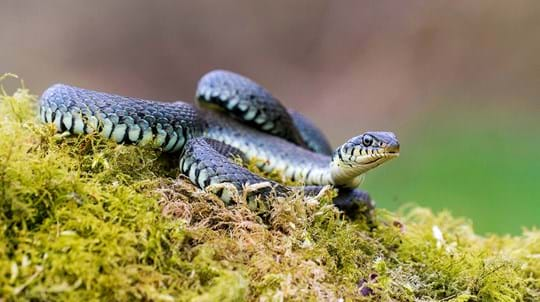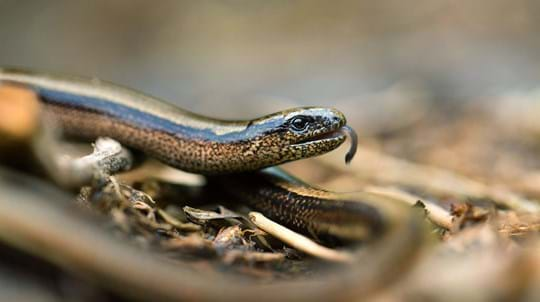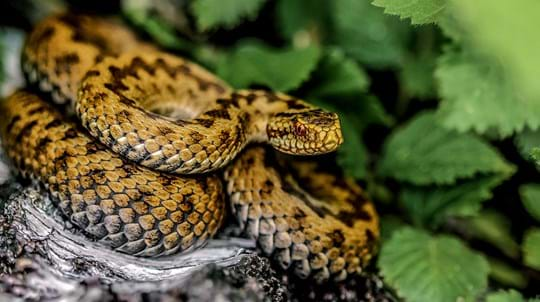
Credit: Oliver Smart / Alamy Stock Photo
What do common lizards eat?
The common lizard feeds on small invertebrates such as flies, spiders and even snails. It hunts by day using sight and scent, warming its body first by basking in the sun.
Timid, lightning-quick and sun-worshipping. The common lizard basks in the warmth of the sun along woodland edges, sunny glades and rides. It stays close to dense cover so it can quickly hide among twigs, logs and leaves.
Common names: common lizard, viviparous lizard
Scientific name: Zootoca vivipara
Family: Lacertidae (lizards)
Habitat: open woodland, heathland, moorland and sometimes gardens
Diet: insects, spiders and other invertebrates
Predators: birds of prey, crows and other large birds, foxes and domestic cats
Origin: native
While it varies in colour from black to vivid green, the common lizard is usually brown with a pattern of stripes or spots. It has scaly skin, a small, pointed head and measures around 10–15cm in length. Its tail makes up over half of its length. Males have bright yellow or orange-speckled bellies whereas females have paler, plain undersides.
Not to be confused with: the sand lizard, a larger, brighter and much rarer egg-laying relative found on coastal dunes in the south and west of the UK.

Credit: Oliver Smart / Alamy Stock Photo
The common lizard feeds on small invertebrates such as flies, spiders and even snails. It hunts by day using sight and scent, warming its body first by basking in the sun.
The word ‘viviparous’ means ‘to bear live young’, which have developed inside the body of their mother, rather than in laid eggs.
Instead of laying eggs, this lizard bears ‘live young’. Mating takes place in late spring, after which up to 10 young develop inside the female, giving her a fattened, pregnant look. The young are then ‘born’ in July.

Credit: David Sewell / Alamy Stock Photo
Without a way to heat their own bodies, ‘cold-blooded’ reptiles such as lizards rely on the warmth of the sun to remain active. Between October and March they hibernate beneath rocks and fallen logs, emerging in spring as temperatures rise.
Common lizards are widespread throughout the UK and are the only reptile native to Ireland. They are found in grassland, heathland, woodland edges, moorland and sometimes gardens, often bathing in spots of sunshine.

Credit: Geoff Smith / Alamy Stock Photo
Walk slowly and scan the margins between dry paths and vegetation. Focus on sunny open areas and possible basking places, such as brash piles, low logs and open grassy spots. The rustling movement of a lizard darting for cover is often the first sign you’ll get, but it’s worth returning – lizards stick to the same basking spots.
When under attack by a predator, this lizard can shed its tail, which will continue to move as a distraction, allowing it to escape.
Although the species is widespread, the common lizard is in decline due to habitat loss. It is protected under UK law, however, meaning that it is an offence to deliberately sell, trade, injure or kill a common lizard.

Amy Lewis • 25 Mar 2022
Found a small, brown, cold-blooded animal and not sure what it might be? You're not alone! Our guide looks at the telltale signs for separating your newts from your lizards.
Start identifying
Trees woods and wildlife
Grass snakes are the UK's most common snake species. Find out what they eat, where they live and how they breed.

Trees woods and wildlife
Discover the slow worm, a legless lizard which resembles a snake. Find out what it eats, where it lives and how it breeds.

Trees woods and wildlife
The adder is the UK's only venomous snake, but it's incredibly shy of people. Discover its little known mating rituals, unusual facts, folklore and more.